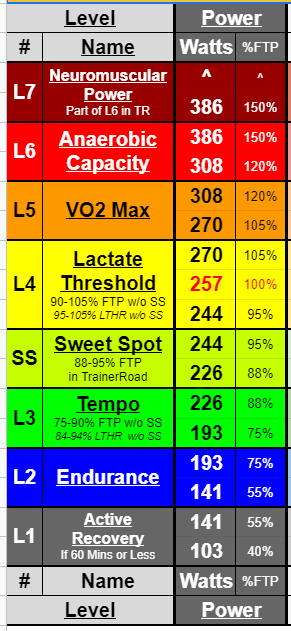The power target it changed too based on the levels.
Guess I’ll have to see how close it gets to what is calculated using what I posted above. I still think once you get the hrv code into the app it wouldn’t hurt to capture it during a ramp test. Thanks for the clarification
@mcneese.chad have you seen your power targets change for intervals based on what Nate said about adaptive training?
Here are my zones pulled from my ride last night, that is after my Ramp on Tues (based on 257w FTP).
And for reference, here is my info per the 7- Level Coggan data:
There are some subtle differences of a couple watts between the two. No idea if that is the same as old or new? I don’t often look this closely at my post ride wattage on that table. And AFAIK, that is the only way to see your “Zones”. There is no way to access in your career or account tabs.
Comparing to your previous screen shot it looks like the zones changed but will need a bigger screen to see if the percent changed. Guessing you aren’t in xert to compare how the two track.
My opinion based on what I’ve seen of xert discussions is that the zones aren’t generic for a given ftp but unique per person. Not sure how rpe helps with endurance zone work. Shouldn’t those rides always be easy? So how do you know if it’s not too easy?
If you are comparing to one way up, that is likely from before, when I had a 251w FTP in TR.
The ones most recent above:
… are reflecting my updated 257w FTP, so keep that in mind.
I guess I need to do a double data check with my Google sheet to the old 251w FTP to see how it alingns.
RPE is an obvious marker. Does it match the endurance zone below LT1 / VT1? Post workout analysis what’s the HR / Power decoupling look like? Way over 10% , either the power was too high or duration too long. Between 5-10% probably about right but you shouldn’t progress beyond current power and duration. Decoupling below 5% , you are ready to extend the duration or increase power.
Plenty of ways to adapt endurance workouts. I tend to do these outside based on RPE and HR. How do I know what pace to work at? I do the talk test through out my ride. I try and recite the alphabet, and see if I can complete A-Z without taking a breath. Depending on how far I get tells me whether I’m working at just the right intensity or not.
RPE should always be easy for an endurance workout right? That would be a way to tell if you’re pushing too hard. But how do you know if you’re pushing too little? Check if decoupling is over 5%? Which way of calculating decoupling? Thanks
Find the upper bound of your easy by RPE. Then stay not too far below it. You will get a feel for it. The effort should feel fairly constant even downhill. Looking at my HR trace for today it mostly stayed in a 10 bpm range.
You should see hardly any decoupling if working easy unless.
- You have extended the duration from what you are used to.
- You are actually working too hard.
- It’s really hot and / or you aren’t keeping hydrated and cool enough.
But decoupling is something you look at in your post ride analysis. Once decoupling is below 5% , it’s time to extend the duration to keep progressing. If it’s above 5% stick to the duration you are currently doing.
During the ride use RPE as your guide. HR can help as well but always calibrate it to your RPE during each long ride.



